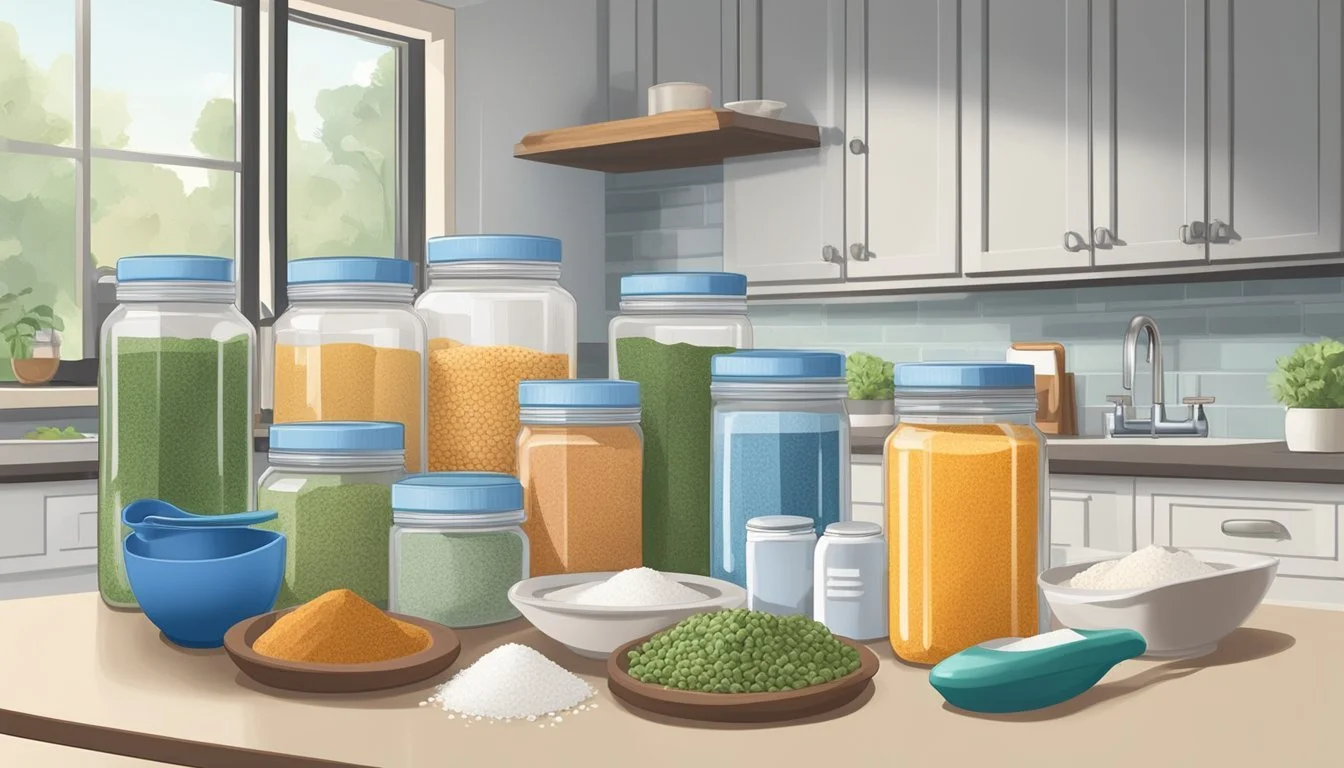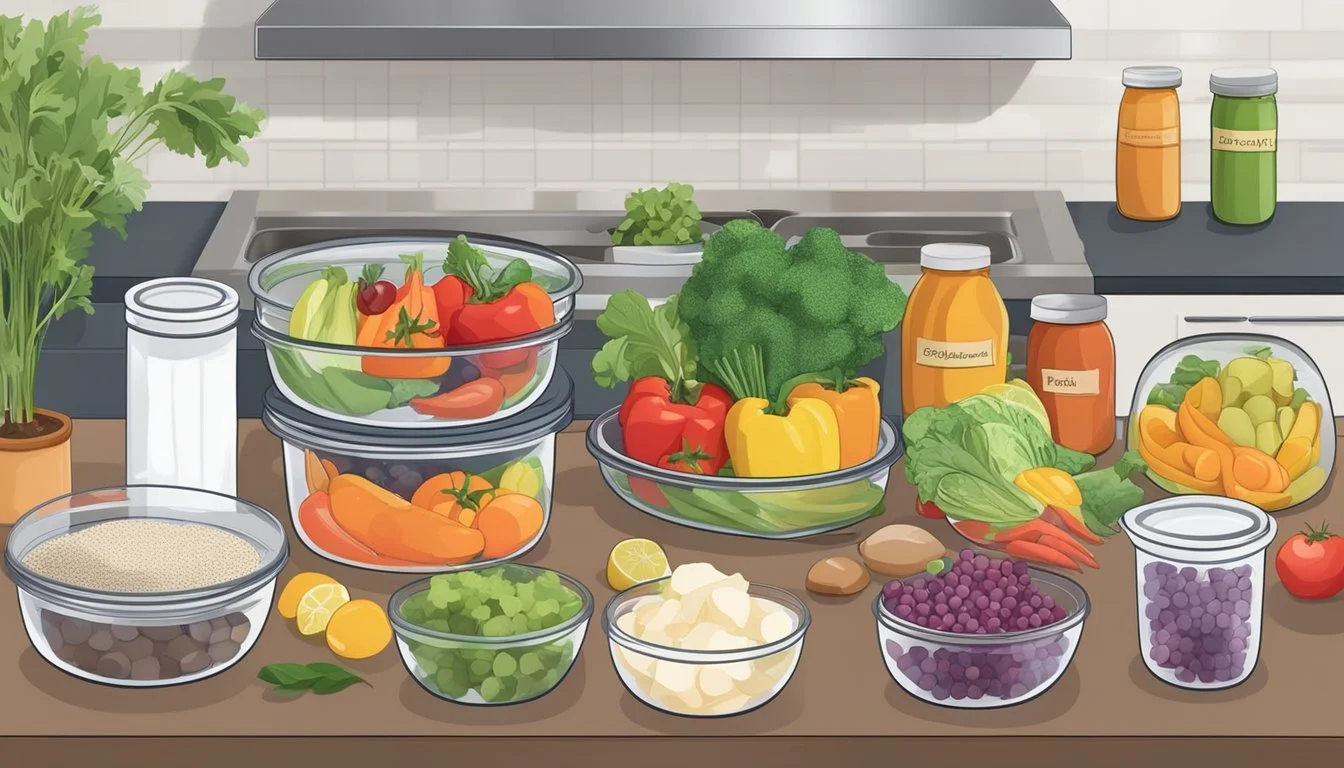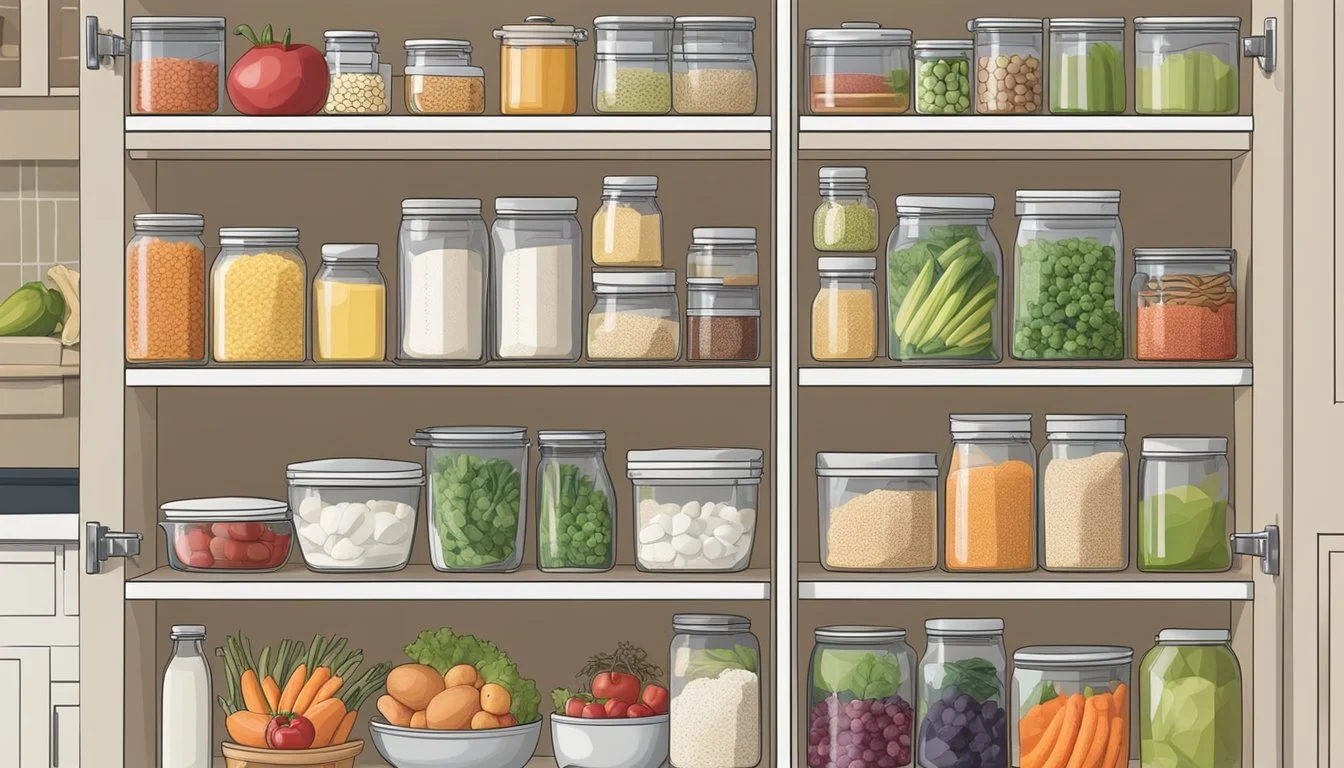Organizing Your Kitchen for a Low-Sodium Diet
Simple Steps for Healthier Eating
Maintaining a low-sodium diet is essential for managing and preventing a host of medical conditions, including high blood pressure, heart disease, and kidney disease. Sodium is a critical electrolyte in the human body, but too much of it can lead to health complications. Therefore, organizing one's kitchen to support a low-sodium lifestyle becomes a foundational step in promoting a healthy diet and overall well-being.
For individuals navigating the transition to reduced sodium intake, it is important to prioritize fresh and unprocessed foods, as these tend to contain naturally lower levels of sodium. Fresh meats, fruits, and vegetables are the cornerstones of a diet that aims to minimize salt intake. Reading food labels diligently is a key practice when selecting prepackaged items, as it helps in identifying products with low sodium content that are conducive to a heart-healthy kitchen.
The kitchen environment can either facilitate or hinder diet adherence, thus properly arranging one's cooking space is crucial in making a low-sodium diet manageable and sustainable. By stocking the pantry with spices and herbs that can replace salt in recipes, and by strategically placing healthy snacks and ingredients within easy reach, individuals can make significant strides towards achieving their dietary goals and improving their health outcomes.
Understanding Sodium in Your Diet
Sodium plays a crucial role in maintaining fluid balance and nerve function, but excessive intake can lead to health risks such as high blood pressure and heart disease. It is important to understand how much sodium is necessary for the body and where it can be found in the diet.
The Role of Sodium in the Body
Sodium is a mineral essential for the body's fluid balance, nerve transmission, and muscle function. It works in concert with potassium to maintain the correct balance of fluids in and around cells, which is vital for normal bodily functions.
Sodium and Health Risks
High sodium intake is known to increase blood pressure, a condition known as hypertension. This elevation in blood pressure heightens the risk of developing heart disease or experiencing a stroke. To mitigate these risks, monitoring and managing sodium consumption is crucial.
Recommended Sodium Intake
The recommended daily sodium intake varies depending on age, health status, and individual health guidelines. However, a general guideline is to consume no more than 2,300 milligrams per day for healthy adults. People with certain health conditions, such as heart failure or hypertension, may need to limit their sodium intake even further to around 1,500 to 2,000 milligrams per day.
Understanding and controlling sodium intake is an important step in preventing high blood pressure and maintaining overall heart health.
Identifying High-Sodium Foods
The importance of recognizing high-sodium foods is crucial for maintaining a low-sodium diet. This helps individuals make informed decisions and maintain control over their sodium intake.
Common High-Sodium Culprits
Processed Foods: Pre-packaged meals, fast foods, and restaurant foods are significant sources of sodium because salt is commonly used to enhance flavor and preserve food. Items such as salty snacks, certain breads, and processed cheeses also fall into this category.
Canned Foods: Canned vegetables, soups, and beans often contain added sodium for preservation. Rinsing these foods can help reduce the sodium content.
Processed Meats: Meats like bacon, ham, sausages, and deli meats typically have high levels of salt for flavor and preservation.
Sauces and Condiments: Ketchup, mustard, soy sauce, barbecue sauce, and salad dressings can be surprisingly high in sodium.
Understanding Food Labels
Food labels are a valuable tool for identifying high-sodium foods. They indicate sodium content per serving, allowing consumers to choose options that align with a low-sodium diet.
Look for labels that show sodium amounts lower than 5% of the daily value, as these are considered low in sodium.
Foods with more than 20% of the daily value for sodium are categorized as high-sodium foods.
Unexpected Sources of Sodium
Some foods that may not taste salty can still contain high levels of sodium, making label reading essential.
Bread and Cheeses: Though not always overtly salty, these can have hidden sodium content that accumulates with frequent consumption.
Salted Nuts: Snacks like salted nuts may add significant amounts of sodium to your daily intake even in small quantities.
By identifying and understanding which foods are high in sodium, individuals can make conscious choices to reduce their intake, benefiting overall health and well-being.
Planning a Low-Sodium Diet
Embarking on a low-sodium diet begins with informed planning, the foundation of which involves understanding food labels, stocking up on the right ingredients, and strategizing grocery shopping to support healthier, sodium-conscious choices.
Setting Up for Success
A successful low-sodium diet requires awareness of one’s current sodium intake and establishing a target goal, often no more than 2,300 milligrams daily as recommended for a general diet and further reduced to 1,500 milligrams for specific health conditions. Emphasizing fresh fruits and vegetables, which are naturally low in sodium, and incorporating a variety of whole grains into meals serve as a solid foundation. Integrating unprocessed, lean proteins and using herbs and spices, in place of salt, can profoundly transform the flavor profile without adding sodium.
Shopping Tips for Lower Sodium
When shopping:
Always read food labels; compare products and choose options with less sodium.
Prefer fresh or frozen produce over canned, which often contains added salt.
Select "no salt added" or "low-sodium" versions of packaged foods.
Purchase fresh cuts of chicken, beef, pork, or fish rather than smoked or processed meats.
Here is a quick-reference shopping list for a low-sodium diet:
Food Category Items to Choose Fruits Fresh or frozen without added sugar Vegetables Fresh or frozen without added sauce Grains Brown rice, quinoa, whole wheat Protein Fresh cuts of meat, beans, tofu Dairy Low-sodium cheese, plain yogurt Condiments Vinegars, spice blends without salt Fats Olive oil, unsalted nuts
Creating a Low-Sodium Pantry
Building a low-sodium pantry is about keeping the right items on hand that align with health goals. Stock items like:
Whole grains such as quinoa, brown rice, and whole wheat pasta.
A variety of spices and herbs to enhance flavors without adding salt.
Olive oil and vinegar for salad dressings and low-sodium cooking options.
Unsalted nuts for healthy snacking.
Shelf-stable produce like potatoes, onions, and garlic to enrich dishes with flavor.
Cooking and Seasoning Without Salt
Transitioning to a low-sodium diet requires an exploration of various salt-free cooking methods and seasoning alternatives that still impart rich flavors to your meals.
Salt-Free Cooking Techniques
For a successful low-sodium kitchen, one must master certain cooking methods that enhance the natural taste of food. Searing, roasting, and grilling can develop deep flavors without the need for salt. Additionally, techniques such as steaming or poaching with aromatic liquids like lemon juice, vinegar, or sodium-free broth can infuse dishes with subtle, fresh flavors.
Using Herbs and Spices for Flavor
To compensate for the lack of salt, a broad palette of herbs and spices is vital. Use fresh or dried herbs like basil and thyme to add a vibrant, aromatic touch to dishes. Spices such as ginger, garlic powder, and paprika offer a zesty kick and complexity to recipes. For a citrus note, lemon zest can brighten up any dish. One can create their own blends, or purchase salt-free options such as:
Cayenne-flecked BBQ seasoning for a taste of Louisiana.
Dash Fiesta Lime or similar blends for a spicy, tart flavor.
Salt Substitutes and Alternatives
While reducing sodium, there are creative ways to use substitutes that provide savory flavors. Nutritional yeast imparts a cheese-like taste and healthy fats such as avocado or olive oil add richness. For a punchy taste, freshly ground black pepper or a squeeze of citrus juice can make a world of difference. Consider the following salt-free alternatives:
Sesame seeds or blends resembling everything bagel seasoning without salt.
Vinegars, such as balsamic or red wine, which add depth and tanginess to foods.
Reimagining Meals and Snacks
When adopting a low-sodium diet, one should focus on selecting whole foods that are naturally low in sodium and prepare meals that include fresh proteins, dairy, and produce. These foods can be combined creatively to create flavorful breakfast, lunch, dinner, and snack options without relying on high-sodium ingredients.
Breakfast Options
For breakfast, an individual can opt for eggs, which can be prepared in various ways such as boiled, poached, or scrambled. Pairing eggs with a slice of whole grain bread and a serving of fresh fruits creates a balanced meal:
Eggs: Boil, scramble, or poach.
Whole Grains: Opt for sodium-free or low-sodium bread.
Fruits: Include a mix like apples, berries, or oranges.
Lunch and Dinner Ideas
Lunch and dinner can focus on lean proteins like chicken, turkey, and fish. Accompany these proteins with a generous helping of vegetables and beans for added nutrients and fiber:
Proteins:
Grilled chicken breast
Turkey slices
Vegetables:
Steamed broccoli, carrots, and bell peppers
Fresh salads with a homemade dressing of olive oil and herbs
Roasted sweet potatoes
Legumes:
Bean chili
Chickpea salad
Healthy Snack Choices
Snacks can comprise unsalted nuts and seeds, dairy products like cottage cheese, and cut vegetables. These snacks provide essential nutrients and help maintain energy levels throughout the day:
Nuts/Seeds: Almonds, walnuts, or pumpkin seeds without added salt.
Dairy: Low-sodium cheese like Swiss or mozzarella, or plain Greek yogurt.
Veggies: Baby carrots, sliced cucumber, or cherry tomatoes.
By focusing on these food choices, individuals can enjoy a diverse and nutritious low-sodium diet.
Navigating Dining Out on a Low-Sodium Diet
Eating out on a low-sodium diet requires a proactive approach to choosing restaurants and menu items while effectively communicating with restaurant staff. It's crucial to plan ahead to maintain a diet that aligns with guidelines such as those recommended by the American Heart Association.
Choosing the Right Restaurants
Before dining out, individuals should research and select restaurants that offer nutrition information either on their websites or upon request. Some establishments cater to health-conscious diners with menus featuring lower sodium options. Opting for restaurants that cook to order allows for more customization and control over the sodium content in food.
Making Smart Menu Choices
Once at the restaurant, it's essential to navigate the menu with a clear understanding of which items are typically high in sodium. Processed and cured meats, dishes with cheese, and anything pickled or smoked are generally high in sodium. Instead, diners can seek out dishes featuring fresh vegetables, lean proteins, and whole grains.
Appetizers: Choose salads with dressing on the side, or fresh fruit or vegetable-based dishes.
Main Course: Look for grilled, baked, or steamed options, and request no added salt.
Sides: Steamed vegetables, plain rice, or potatoes without added sauces or seasonings are safer choices.
Talking to Staff About Sodium
Communication with restaurant staff can greatly influence the sodium content of the meal. Diners should not hesitate to ask questions about the menu and request modifications such as:
No added salt or MSG in the preparation of the dish.
Salad dressings and sauces on the side to control the amount used.
Details about the sodium content in specific dishes, if available.
Being specific and courteous with requests can lead to a meal that is both enjoyable and compliant with a low-sodium dietary regimen.
Adapting to a Low-Sodium Lifestyle
Transitioning to a low-sodium lifestyle requires thoughtful changes in the kitchen and understanding the emotional and social intricacies involved. It's about forming new habits that support long-term health and wellbeing, particularly relevant in the American context where average sodium intake exceeds health recommendations.
Emotional and Social Considerations
Adapting eating habits: Individuals must acknowledge the change as a positive step towards better health. This can involve a shift in how one views cooking and consuming food, moving away from high-sodium products and embracing flavor through herbs and spices.
Family meal planning: Involving family members in meal planning and preparation can make the transition smoother. Everyone's buy-in is crucial, especially when adjusting favorite recipes to low-sodium versions.
Support system: Building a strong support system is vital. Living with a low-sodium diet can be challenging, so having friends or family who understand and support these dietary changes can significantly help with adherence.
Maintaining a Low-Sodium Diet Long-Term
Establishing habit forming: Transitioning to a low-sodium diet is not a temporary phase, but a lifelong commitment. This requires establishing new cooking and eating habits, like reading labels for sodium content and cooking more meals at home.
Read labels diligently to identify low-sodium products.
Cook using fresh meat and vegetables, avoiding processed foods.
Lifestyle changes for long-term health: The goal is to protect and enhance long-term health, which often involves more than just dietary adjustments.
Emphasize the importance of regular physical activity and stress management in conjunction with a low-sodium diet.
Regular health check-ups are recommended to monitor the impact of these lifestyle changes.
Special Considerations for Specific Diets
Organizing a kitchen for a low-sodium diet requires attention to individual needs and the specific parameters of one's chosen eating plan. Whether someone adheres to a vegetarian and vegan diet or explores restrictive regimens such as paleo, each comes with unique considerations.
Vegetarian and Vegan Diets
Individuals on vegetarian or vegan diets must carefully select low-sodium options that meet their protein requirements. They should prioritize fresh produce and whole grains while being cautious of high-sodium processed substitutes often used in vegetarian products. Key sources of low-sodium protein for vegetarians and vegans include:
Legumes: beans, lentils, chickpeas
Nuts and Seeds: almonds, walnuts, chia seeds
Tofu and Tempeh: unsalted or low-sodium versions
Dairy Products (for vegetarians): opt for fresh or low-sodium cheese and Greek yogurt
Vegans should also ensure adequate B12 intake, which can be found in fortified, low-sodium plant milks alternative to dairy products.
Paleo and Other Restrictive Diets
Those following a paleo diet or other restrictive dietary regimes focus primarily on the consumption of foods that would have been available to our Paleolithic ancestors. This inherently eliminates most high-sodium processed foods. Key recommendations include:
Fresh Meats: Beef, poultry, and pork should be free of added salts and flavors.
Fish and Seafood: Look for wild-caught options and avoid brined or pre-seasoned varieties.
Vegetables and Fruits: All fresh, with particular emphasis on leafy greens and seasonal produce.
When organizing the kitchen, they must also consider cross-contamination with foods that don't conform to their dietary restrictions and separate low-sodium seasonings from regular ones.
Resources and Support
For individuals navigating a low-sodium diet, a wealth of resources and support systems exist to aid in organizing the kitchen and meal preparation. These tools provide both educational insights and communal backing to foster a successful dietary transition.
Educational Materials and Guidelines
A plethora of educational materials is available to assist with low-sodium cooking. Cookbooks and online platforms like The Kitchn and EatingWell offer low-sodium meal plans, recipes, and tips to modify traditional cooking methods. These resources usually offer nutritional information for recipes, enabling one to make informed choices.
Books: "The No-Salt Cookbook" and "500 Low Sodium Recipes"
Websites: EatingWell, Kitchn, Trifecta Nutrition
In terms of guidelines, the FDA recommends individuals adhere to a daily sodium intake of less than 2,300 mg. Food labels serve as critical tools to monitor this intake, with 5% DV or less considered low in sodium, and 20% DV or more labeled as high.
Support Groups and Communities
Support groups provide a significant layer of communal reinforcement for those on a low-sodium diet. Many online forums and local health centers offer support groups where individuals can share experiences, advice, and recipes.
Online communities serve as a repository of collective knowledge where members can find companionship in others dealing with similar dietary changes. Platforms like Low Sodium Cooking on Facebook or the DailyStrength online support group for heart disease patients help maintain motivation and offer practical advice.
Online Support Groups:
Facebook Groups such as "Low Sodium Cooking"
DailyStrength online forums
Moreover, involvement in these communities often affords individuals the support they need to persist with their dietary changes. They can exchange insights on meal prepping, label reading, and navigating dining out without straying from their low-sodium goals.








